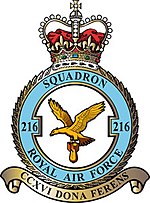No. 16 Squadron RNAS
| No. 216 Squadron RAF | |
|---|---|
 |
|
| Active | 5 October 1917 – 1975 1979 – 20 March 2014 |
| Role | Air Transport / Air-to-Air Refuelling |
| Garrison/HQ | RAF Brize Norton |
| Motto(s) |
CCXVI dona ferens Latin:"216 bearing gifts" |
| Equipment | Lockheed Tristar |
| Battle honours | Independent Force and Germany 1917–1918, Egypt and Libya 1940–1942, Greece 1940–1941, Syria 1941, El Alamein, North Africa 1943, North Burma 1944, South East Europe 1944–1945, Kosovo |
| Insignia | |
| Identification symbol |
An eagle, wings elevated, holding a bomb in its claws |
No. 216 Squadron was a squadron of the Royal Air Force and, before disbandment operated the Lockheed Tristar K1, KC1 and C2 from RAF Brize Norton, Oxfordshire.
216 Squadron was formed at RAF Manston by re-numbering No. 16 Squadron RNAS when the RAF was established in 1918. Initially with the Handley Page O/100 bomber and later with the Handley Page O/400.
Between the two world wars the squadron used Vickers Vimy, Vickers Victoria and Vickers Type 264 Valentia aircraft on transport duties around the Middle East.
During the Second World War, with a few exceptions, such as the attacks from 17 to 21 June 1940 by single aircraft of No. 216 Squadron on the airfields of El Adem and Tobruk, the unit was principally a transport squadron, operating the Vickers Type 264 Valentia, Bristol Bombay, Vickers Wellington, Lockheed Hudson and Douglas Dakota. It spent a lengthy time deployed to Greece from October 1944 to August 1946 as the primary transport unit for British forces involved in the Greek Civil War.
In 1949 the Dakotas were replaced by Vickers Valletas and Handley Page Hastings transport aircraft; in 1955 the squadron moved to RAF Lyneham from RAF Fayid in Egypt to operate the DH Comet jet airliner until 1975.
...
Wikipedia
